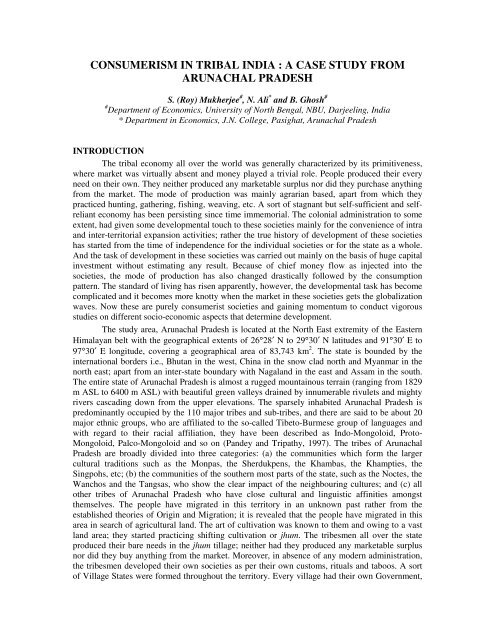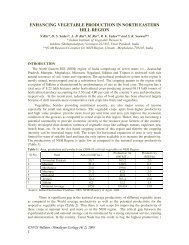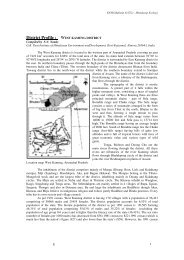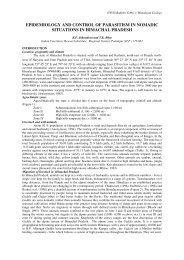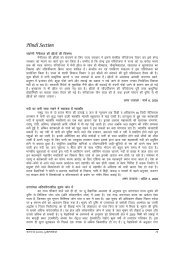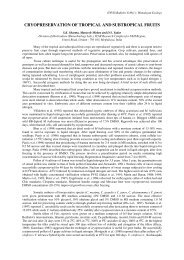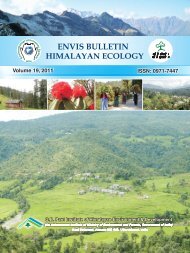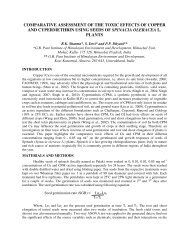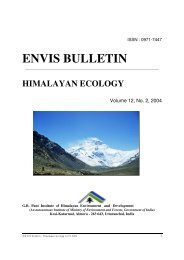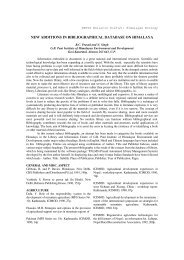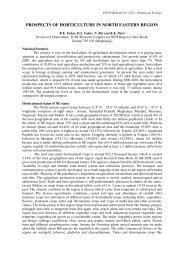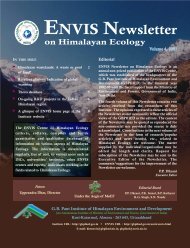consumerism in tribal india : a case study from arunachal pradesh
consumerism in tribal india : a case study from arunachal pradesh
consumerism in tribal india : a case study from arunachal pradesh
Create successful ePaper yourself
Turn your PDF publications into a flip-book with our unique Google optimized e-Paper software.
CONSUMERISM IN TRIBAL INDIA : A CASE STUDY FROMARUNACHAL PRADESHS. (Roy) Mukherjee # , N. Ali * and B. Ghosh ## Department of Economics, University of North Bengal, NBU, Darjeel<strong>in</strong>g, India* Department <strong>in</strong> Economics, J.N. College, Pasighat, Arunachal PradeshINTRODUCTIONThe <strong>tribal</strong> economy all over the world was generally characterized by its primitiveness,where market was virtually absent and money played a trivial role. People produced their everyneed on their own. They neither produced any marketable surplus nor did they purchase anyth<strong>in</strong>g<strong>from</strong> the market. The mode of production was ma<strong>in</strong>ly agrarian based, apart <strong>from</strong> which theypracticed hunt<strong>in</strong>g, gather<strong>in</strong>g, fish<strong>in</strong>g, weav<strong>in</strong>g, etc. A sort of stagnant but self-sufficient and selfrelianteconomy has been persist<strong>in</strong>g s<strong>in</strong>ce time immemorial. The colonial adm<strong>in</strong>istration to someextent, had given some developmental touch to these societies ma<strong>in</strong>ly for the convenience of <strong>in</strong>traand <strong>in</strong>ter-territorial expansion activities; rather the true history of development of these societieshas started <strong>from</strong> the time of <strong>in</strong>dependence for the <strong>in</strong>dividual societies or for the state as a whole.And the task of development <strong>in</strong> these societies was carried out ma<strong>in</strong>ly on the basis of huge capital<strong>in</strong>vestment without estimat<strong>in</strong>g any result. Because of chief money flow as <strong>in</strong>jected <strong>in</strong>to thesocieties, the mode of production has also changed drastically followed by the consumptionpattern. The standard of liv<strong>in</strong>g has risen apparently, however, the developmental task has becomecomplicated and it becomes more knotty when the market <strong>in</strong> these societies gets the globalizationwaves. Now these are purely consumerist societies and ga<strong>in</strong><strong>in</strong>g momentum to conduct vigorousstudies on different socio-economic aspects that determ<strong>in</strong>e development.The <strong>study</strong> area, Arunachal Pradesh is located at the North East extremity of the EasternHimalayan belt with the geographical extents of 26°28′ N to 29°30′ N latitudes and 91°30′ E to97°30′ E longitude, cover<strong>in</strong>g a geographical area of 83,743 km 2 . The state is bounded by the<strong>in</strong>ternational borders i.e., Bhutan <strong>in</strong> the west, Ch<strong>in</strong>a <strong>in</strong> the snow clad north and Myanmar <strong>in</strong> thenorth east; apart <strong>from</strong> an <strong>in</strong>ter-state boundary with Nagaland <strong>in</strong> the east and Assam <strong>in</strong> the south.The entire state of Arunachal Pradesh is almost a rugged mounta<strong>in</strong>ous terra<strong>in</strong> (rang<strong>in</strong>g <strong>from</strong> 1829m ASL to 6400 m ASL) with beautiful green valleys dra<strong>in</strong>ed by <strong>in</strong>numerable rivulets and mightyrivers cascad<strong>in</strong>g down <strong>from</strong> the upper elevations. The sparsely <strong>in</strong>habited Arunachal Pradesh ispredom<strong>in</strong>antly occupied by the 110 major tribes and sub-tribes, and there are said to be about 20major ethnic groups, who are affiliated to the so-called Tibeto-Burmese group of languages andwith regard to their racial affiliation, they have been described as Indo-Mongoloid, Proto-Mongoloid, Palco-Mongoloid and so on (Pandey and Tripathy, 1997). The tribes of ArunachalPradesh are broadly divided <strong>in</strong>to three categories: (a) the communities which form the largercultural traditions such as the Monpas, the Sherdukpens, the Khambas, the Khampties, theS<strong>in</strong>gpohs, etc; (b) the communities of the southern most parts of the state, such as the Noctes, theWanchos and the Tangsas, who show the clear impact of the neighbour<strong>in</strong>g cultures; and (c) allother tribes of Arunachal Pradesh who have close cultural and l<strong>in</strong>guistic aff<strong>in</strong>ities amongstthemselves. The people have migrated <strong>in</strong> this territory <strong>in</strong> an unknown past rather <strong>from</strong> theestablished theories of Orig<strong>in</strong> and Migration; it is revealed that the people have migrated <strong>in</strong> thisarea <strong>in</strong> search of agricultural land. The art of cultivation was known to them and ow<strong>in</strong>g to a vastland area; they started practic<strong>in</strong>g shift<strong>in</strong>g cultivation or jhum. The tribesmen all over the stateproduced their bare needs <strong>in</strong> the jhum tillage; neither had they produced any marketable surplusnor did they buy anyth<strong>in</strong>g <strong>from</strong> the market. Moreover, <strong>in</strong> absence of any modern adm<strong>in</strong>istration,the tribesmen developed their own societies as per their own customs, rituals and taboos. A sortof Village States were formed throughout the territory. Every village had their own Government,
own territory and own adm<strong>in</strong>istration. The Gambura led the society on basis of the Kebangdecision. Although primitive, they led a peaceful life over the generations. In the purely barterform of economy, people exchanged their needs mostly as an <strong>in</strong>tra-tribe and sometimes <strong>in</strong>tertribesbasis. There was no circulation of money nor there existed any market mechanism. Thetradition went on until the Government of India after <strong>in</strong>dependence created the North EastFrontier Agency with effect <strong>from</strong> early 1950’s; the Nehruvian pr<strong>in</strong>ciple of <strong>tribal</strong> development <strong>in</strong>the territory was adopted s<strong>in</strong>ce then. Along with the national ma<strong>in</strong>stream, the territory alsoreceived handsome allocation to start the development process.Follow<strong>in</strong>g the Nehru-Elw<strong>in</strong> theory, the territory takes-off its journey by dispos<strong>in</strong>g thesum <strong>in</strong> road construction, school build<strong>in</strong>g construction and <strong>in</strong>frastructure development programs,by import<strong>in</strong>g the entire technological know-how <strong>from</strong> out side the territory. Therefore, the lionpart went off <strong>from</strong> the state <strong>in</strong> terms of salary and cost of <strong>in</strong>puts. However, a few hands of theterritory itself received a considerable amount, which were <strong>in</strong>fluential to the extent of educationalqualification, social status (village headmen etc.) and political likeness. The classless societyfragmented <strong>in</strong>to classes. In the follow<strong>in</strong>g years, the Ch<strong>in</strong>ese Aggression (1962) made the plannersto feel the development task otherwise. The territory achieved the Union Territory Status <strong>in</strong> theyear 1972 and the first ever General Election was held <strong>in</strong> the year 1978. Thereby people’sparticipation <strong>in</strong> the development activities started to take place. The Plan Allocation for theterritory raised many-a-fold. The <strong>in</strong>itiation of modern political system blessed the society witheasier money flow <strong>from</strong> the Union Government; rather market mechanism did not developed orany noticeable production started to be accrued. The easy money to a large deal dra<strong>in</strong>ed away<strong>from</strong> the state <strong>in</strong> order to purchase ostentative needs for some of the people.MATERIALS AND METHODThe present paper is a broader documentation of obta<strong>in</strong>ed field data relat<strong>in</strong>g toproduction, consumption, <strong>in</strong>vestment and other economic activities performed at the householdlevel at the cross-sections of the <strong>study</strong> area, selected randomly keep<strong>in</strong>g various diversities <strong>in</strong>m<strong>in</strong>d. Data gathered <strong>from</strong> the field have aga<strong>in</strong> been checked with very sparsely availableGovernment level publications and other related references. Filtered data have been analyzedstatistically for accru<strong>in</strong>g the result discussed henceforth. For the sake of an extensive <strong>study</strong>,<strong>in</strong>terview was taken <strong>from</strong> the various age groups of people with a sample size of 120 cover<strong>in</strong>g 24villages of 8 districts of the state <strong>in</strong> order to sketch out their varied perceptions on consumptiondoma<strong>in</strong>.Table 1. Occupational structure of the sample householdsName of the occupation No. of Respondents % of the respondentsLandless agricultural labour 9 7.5Landless non-agricultural labour 4 3.33Marg<strong>in</strong>al cultivators 7 5.83Small cultivators 13 10.83Medium cultivators 29 24.16Large cultivators 9 7.5Bus<strong>in</strong>ess and supply19 15.83(<strong>in</strong>clud<strong>in</strong>g Govt. contractors)Service 28 23.33Other (not mentioned) 2 1.66Total 120 100Table 2: Family <strong>in</strong>come of the sample households (Rs. /Year)Income level No. of respondents % of the Respondents
subsistence activities like gather<strong>in</strong>g, rear<strong>in</strong>g, and fish<strong>in</strong>g etc. based on the local forest resources.However, ‘hunt<strong>in</strong>g’ is a practice, persist<strong>in</strong>g <strong>in</strong>to the society irrespective of any economic group.It is however, to note that the present <strong>study</strong> has revealed the fact that at around 90% ofthe people <strong>in</strong> the <strong>study</strong> area are liv<strong>in</strong>g with middle and high <strong>in</strong>come, contrary to the generalperception that the <strong>tribal</strong> people are generally backward and liv<strong>in</strong>g below the poverty l<strong>in</strong>e.Poverty persists there rather <strong>in</strong> very shadow form. Apart <strong>from</strong> their known sources of <strong>in</strong>come,easy money flow <strong>in</strong>to their economy. Field <strong>study</strong> reveals a vertical mobility of the occupationalstructure of tribesmen as well as their consumption pattern.The <strong>tribal</strong> society <strong>in</strong> the <strong>study</strong> area has shown the tendency of a steady rise of <strong>in</strong>comelevel, when the collected field data has been compared with the available secondary data. Out ofthe 120 samples, 90 (75%) families were found to have an annual <strong>in</strong>come of Rs. 100,000 orabove; surely belong to the ‘High Middle Class to Higher Income Group’ categories. Thus,consumption pattern of the tribesmen as found <strong>from</strong> the field survey (Table 3) has also beenevolved likewise.It is however, to note the fact that very small amount of the total <strong>in</strong>come (3%), theaverage households do spend on food. This is because of the fact that the tribesmen do produceall their the necessary requirements for food <strong>from</strong> their farms and merely the items, which couldnot be produced <strong>in</strong> the farm sector, are bought <strong>from</strong> the market; these <strong>in</strong>clude salt, sugar, mustardoil and so on.Apart <strong>from</strong> food, they do spend a very trivial amount on their shelter. Construction ofhouse is not a regular phenomenon for the tribesmen <strong>in</strong> the <strong>study</strong> area. At an average, the localpeople build their house every 10 years; moreover, the materials for construction are collected<strong>from</strong> local forests too. Apart <strong>from</strong> these, the required labour is gathered <strong>from</strong> the community; sothat the cost of construct<strong>in</strong>g houses is nom<strong>in</strong>al as compared to the other components of totalexpenditure.Education is now an emerg<strong>in</strong>g phenomenon among the of <strong>tribal</strong>s. The average <strong>tribal</strong>family spends a considerable portion of the total <strong>in</strong>come on education of their wards <strong>in</strong> the formof school/ college tuition fees, hostel fees, cost of dresses and educational stationeries, tuition feesfor the private tutors, etc. As it is revealed <strong>from</strong> the field survey that the wards of a bit well-to-dofamilies are accommodated <strong>in</strong> the school hostels <strong>in</strong> the far flung urban centres and because oflesser density of higher educational <strong>in</strong>stitutions, the students have to stay <strong>in</strong> the hostels and otherself-arranged rental houses dur<strong>in</strong>g their <strong>study</strong> <strong>in</strong> colleges and <strong>in</strong>stitution of higher studies. As wefound <strong>from</strong> the sample universe, an average of 10% of the total <strong>in</strong>come is spent for education.Another noteworthy component of the total expenditure was the 12% expenditure of theirtotal <strong>in</strong>come on medic<strong>in</strong>e and other health related problems – a very much uncommonphenomenon so far <strong>in</strong> the <strong>study</strong> area. It was even some decades ago, that the local miris (villagemedic<strong>in</strong>e man) had taken care of the physiological problems by means of traditional system ofmedic<strong>in</strong>e, which radically disappeared because of the active presence of modern form ofallopathic medic<strong>in</strong>e and Medicare. Although the rugged topographical features retard theadequate growth of <strong>in</strong>frastructural facilities <strong>in</strong> the <strong>study</strong> area, the people of remote villages stillprefer to go to the health centres of modern medic<strong>in</strong>e and sometime they do prefer to be present<strong>in</strong> the luxurious nurs<strong>in</strong>g homes located outside the state. Thus, expenditure on medic<strong>in</strong>e has risenconsiderably <strong>in</strong> the <strong>study</strong> area.Expenditure on cosmetics and recreation are other new dimensions of the <strong>tribal</strong> livelihoodas it is found <strong>from</strong> the field <strong>study</strong> that the younger generation uses imported cosmetics of highprice. And the expenditure on recreation has been raised rapidly <strong>in</strong> the form of television andother electronic media of enterta<strong>in</strong>ment; although liv<strong>in</strong>g <strong>in</strong> the remote villages, the facilities havean active presence <strong>in</strong> the <strong>study</strong> area.
S<strong>in</strong>ce the field survey was conducted among the villagers, who are basically attached tothe agricultural activities directly or <strong>in</strong>directly, they do have an expenditure <strong>in</strong> the form ofpurchas<strong>in</strong>g farm <strong>in</strong>put; although very <strong>in</strong>significant (4%). The medium and large cultivators are<strong>in</strong>vest<strong>in</strong>g a considerable amount of their total <strong>in</strong>come to purchase modernized farm <strong>in</strong>puts such asfertilizer, <strong>in</strong>secticides, pesticides, fungicides, hybrid seeds and sometime they do employmechanized farm equipments like tractor, power tiller, sprayer etc. hired <strong>from</strong> the Department ofAgriculture and other organizations.From the analysis of the distribution of consumption expenditure (Table 3) it is revealedthat the high percentage of consumption expenditure (91.2%) of the sample households impliestheir marg<strong>in</strong>al propensity to save (MPS) is automatically low. This may be the reason that the<strong>tribal</strong> communities <strong>in</strong> the <strong>study</strong> area have taken the first generation test of liquid money that too<strong>in</strong> the era of globalization and consumerization (Roy Mukherjee et al., 2006).CONCLUSIONExperience gathered through this <strong>study</strong> shows that the <strong>tribal</strong> society <strong>in</strong> the <strong>study</strong> area is <strong>in</strong>transition. But the changes are not synonymous when compared to the other parts of the countryor the world. Changes are rapid and sometimes jumbl<strong>in</strong>g to the heights without obey<strong>in</strong>g anyestablished theory of social transition. Impelled <strong>from</strong> the way of the modern liv<strong>in</strong>g, the tribesmenare now runn<strong>in</strong>g after cheap money easily available at their surround<strong>in</strong>gs <strong>in</strong> the form of abundantnatural resources, which they are exploit<strong>in</strong>g without car<strong>in</strong>g the future consequences. The morallimitations, by which the tribesmen were once guided to protect their environment with<strong>in</strong> thetraditional framework and had a deep belief on the mother nature, has been detracted to a largeextent due to the outrageous presence of so-called market forces, which are more prom<strong>in</strong>ent <strong>in</strong> thedays of globalization and consumerization. The faster rate of degradation of natural resources <strong>in</strong>the <strong>study</strong> area thus warrants further studies.REFERENCESBhattacharjee, R.P. 2000. Economic Development of Arunachal Pradesh, Himalayan Publishers,Itanagar.Bower, U.G. 1953. The Hidden Land, John Hurry, London.Choudhury, J.N. 1985. Arunachal Through the Ages, Mrs. J.N. Choudhury, Shillong.Dalton, E.T. 1973. Tribal History of Eastern India, Cosmo Publications, Delhi.Director of Economics and Statistics. 2001. Economic Review of Arunachal Pradesh,Government of Arunachal Pradesh, Itanagar.Pandey, D. and Tripathy, B. 1997. A Comprehensive History of Arunachal Pradesh (Fromearliest Time to 1947 AD), Bani Mandir Publications, Pasighat Arunachal Pradesh.Roy Mukherjee. S., Ali, N. and Ghosh B. 2006. ‘Globalization and Environmental Quality: TheTribal Ethics <strong>from</strong> Arunachal Pradesh’. Paper presented at the National Sem<strong>in</strong>ar onEnvironment and Susta<strong>in</strong>able Development at University College, Raiganj.


